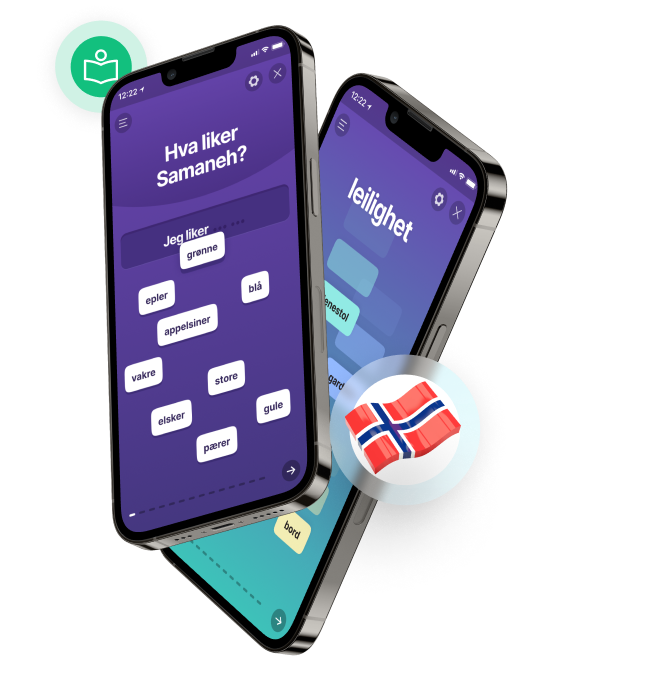Let’s talk adjectives
I’ve been teaching Norwegian for several years now and I never get tired of teaching my students how to decline adjectives correctly. Let’s talk adjectives!

The reason I love sharing Norwegian adjective rules with students is because we actually do have rules and if you understand them – you will never make another adjective mistake!
In this post I’m going to go through the main patterns and exceptions for adjectives positioned in front of an indefinite noun
Continue reading and step up your game
It’s a known fact that native speakers use more adjectives than non-native speakers. So if you want to speak like a native and be able to express precisely what you mean, continue reading.
The first thing you should know is that Norwegian adjectives do not have a gender of their own. They follow the gender of the noun or the nominal clause they are describing as the function of adjectives is to describe nouns or nominal clauses.
The Norwegian nouns on the other hand, have a grammatical gender. They are masculine, feminine or neutral. The masculine nouns have the article “en” in singular indefinite; the feminine nouns have “ei” and the neutral have “et”.
Here are three nominal clauses (indefinite article + noun):
- En bil (car)
- Ei/en lampe (lamp)
- Et eple (apple)
In plural indefinite, they all often end with “er” regardless of gender (note: there are a lot of exceptions which we wont go further into in this post).
So let’s start with the main pattern for adjectives that describe nouns in indefinite forms. For this example I will use the adjective “fin” is “fine” or “nice” in English.
If want to say a nice car, a nice girl or a nice apple, we have to add the adjective “fin”.
En fin bil
Ei/en fin lampe
Et fint eple
For a masculine and feminine nouns the adjective stays the same, but in neutral you have to add a “t”.
And if you want to say nice cars or nice apples you must add an “e” to the basic form of the adjective.
To fine biler
To fine epler
So the main rules are:
- In masculine and feminine the adjective stays the same;
- In neutral you add an “t”;
- In plural you add an “e”.
| Masculine singular | Feminine singular | Neutral singular | Masculine plural | Feminine plural | Neutral plural |
| En fin bil | Ei/en fin lampe | Et fint eple | Fine biler | Fine lamper | Fine epler |
| En rød bil | Ei/en rød lampe | Et rødt eple | Røde biler | Røde lamper | Røde epler |
| En stor bil | Ei/en stor lampe | Et stort eple | Store biler | Store lamper | Store epler |
Easy, right?
But wait… there are some exceptions.
Keep calm though, the main exceptions are also quite easy to understand and to learn
- Norwegian adjectives that end with a double consonant lose one of them when you add a “t” in neutral.
For example we say en tykk person (a fat person) but et tykt blad (a thick magazine). En grønn plante (a green plant), but et grønt hus (a green house).
- Words ending with “-ig”, consonant + t and nationality words does not get a “t” in neutral.
For example we say et hyggelig hus, et koselig lys - never hyggeligt or koseligt (But they do in several Norwegian dialects, and in our neighboring countries, Sweden or Denmark as some of you may have noticed.)
Other exceptions
- The following Norwegian adjectives get double t for neutral nouns.
Fri, ny, grå, blå
Et fritt land (a free country)
Et nytt kjøkken (a new kitchen)
Et grått hus (a gray house)
Et blått bord (a blue table)
- These Norwegian adjectives do not change with any form of the noun.
Bra Moderne Gratis Felles
- Adjectives ending with –er, -el or –en
In adjectives ending with –er, -el or –en the "e" and the "r", "l", "n" swap places in plural For example:
We say en vakker, gammel, sliten, sikker or voksen person, but voksne, gamle, slitne, sikre or voksne personer.
That’s that.
I hope it was helpful.
One last tip – start using adjectives much more than you do. Your listeners will appreciate it. Actually, you should start right away! Go and stand in front of a mirror and tell you reflection how good it looks by using adjectives, just as Tor in the illustration above.
¿Te gustaría aprender más noruego?
Regístrese hoy y aprenda noruego con nuestro curso de idiomas en línea basado en juegos «Samanehs reise», ¡desde nivel principiante hasta hablante fluido!
Desde NOK 375 per måned



